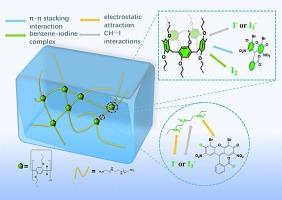一种吸附阴离子染料和碘的高性能超分子聚合物的合成和表征:综合研究
IF 5.2
2区 化学
Q2 CHEMISTRY, PHYSICAL
引用次数: 0
摘要
为了应对日益严重的环境污染挑战,本研究开发了一种能够去除阴离子污染物的高效吸附剂。合成了柱状[5]芳烃(P5),并与聚乙烯亚胺(PEI)交联制备了无孔吸附剂PEI-P5。与多孔材料相比,无孔吸附剂在选择性吸附方面具有独特的优势。合成的PEI-P5含有大量的氨基和胺基,对阴离子污染物的吸附表现出优异的选择性。对阴离子染料具有良好的吸附性能,对伊红B的去除率为98.7%,最大吸附量为633.98 mg/g。对I2/KI的峰值吸附量为1622.80 mg/g,对碘蒸气的峰值吸附量为5000 mg/g。基于Hirshfeld划分(IGMH)和傅里叶变换红外(FTIR)光谱的独立梯度模型分析表明,吸附机制主要为静电相互作用和π-π堆叠相互作用,而范德华力、氢键和CH··I相互作用协同作用。值得注意的是,PEI-P5在模拟现实条件下保持了90%的去除效率,并有效吸附了微量污染物(50 ppb至1 ppm),突出了其环境修复潜力。本文章由计算机程序翻译,如有差异,请以英文原文为准。

Synthesis and characterization of a high-performance supramolecular polymer for the adsorption of anionic dyes and iodine: a comprehensive study
To address the challenge of an increasingly polluted environment, this study developed an efficient adsorbent capable of removing anionic pollutants. Pillar[5]arene (P5) was synthesized and cross-linked with polyethyleneimine (PEI) to form PEI-P5, a non-porous adsorbent. Compared with porous materials, non-porous adsorbents exhibit unique advantages in selective adsorption. The synthesized PEI-P5 contains numerous amino groups and amido groups, and exhibits excellent selectivity for the adsorption of anionic pollutants. It exhibited superior adsorption performance for anionic dyes, with a 98.7 % removal rate for eosin B and a maximum adsorption capacity of 633.98 mg/g. It also demonstrated robust adsorption capabilities for I2/KI, reaching a peak adsorption capacity of 1622.80 mg/g, and for iodine vapor, with an adsorption capacity of 5000 mg/g. Combined analysis through Independent Gradient Model based on Hirshfeld partition (IGMH) and Fourier-Transform Infrared (FTIR) spectroscopy revealed that the predominant adsorption mechanisms involve electrostatic interactions and π-π stacking interactions, while van der Waals forces, hydrogen bonds, and CH···I interactions contribute synergistically to the adsorption system. Remarkably, PEI-P5 maintained >90 % removal efficiency under simulated real-world conditions and effectively adsorbed trace pollutants (50 ppb to 1 ppm), highlighting its potential for environmental remediation.
求助全文
通过发布文献求助,成功后即可免费获取论文全文。
去求助
来源期刊

Journal of Molecular Liquids
化学-物理:原子、分子和化学物理
CiteScore
10.30
自引率
16.70%
发文量
2597
审稿时长
78 days
期刊介绍:
The journal includes papers in the following areas:
– Simple organic liquids and mixtures
– Ionic liquids
– Surfactant solutions (including micelles and vesicles) and liquid interfaces
– Colloidal solutions and nanoparticles
– Thermotropic and lyotropic liquid crystals
– Ferrofluids
– Water, aqueous solutions and other hydrogen-bonded liquids
– Lubricants, polymer solutions and melts
– Molten metals and salts
– Phase transitions and critical phenomena in liquids and confined fluids
– Self assembly in complex liquids.– Biomolecules in solution
The emphasis is on the molecular (or microscopic) understanding of particular liquids or liquid systems, especially concerning structure, dynamics and intermolecular forces. The experimental techniques used may include:
– Conventional spectroscopy (mid-IR and far-IR, Raman, NMR, etc.)
– Non-linear optics and time resolved spectroscopy (psec, fsec, asec, ISRS, etc.)
– Light scattering (Rayleigh, Brillouin, PCS, etc.)
– Dielectric relaxation
– X-ray and neutron scattering and diffraction.
Experimental studies, computer simulations (MD or MC) and analytical theory will be considered for publication; papers just reporting experimental results that do not contribute to the understanding of the fundamentals of molecular and ionic liquids will not be accepted. Only papers of a non-routine nature and advancing the field will be considered for publication.
 求助内容:
求助内容: 应助结果提醒方式:
应助结果提醒方式:


